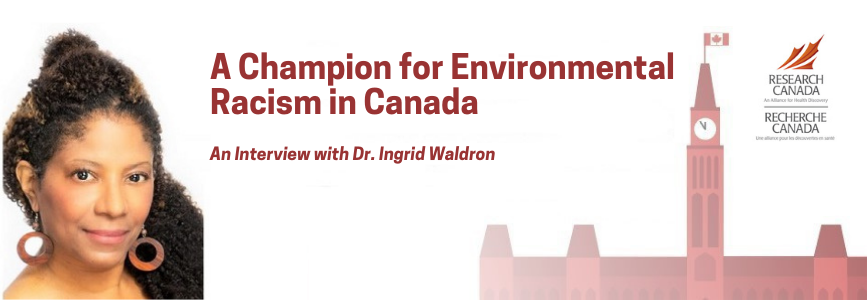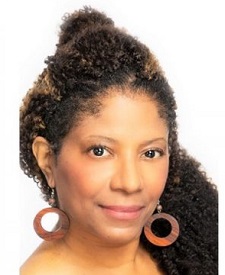

Research Canada speaks to Dr. Ingrid Waldron, champion for environmental racism research in Canada
Dr. Ingrid Waldron is a Professor and the HOPE Chair in Peace and Health in the Global Peace and Social Justice Program in the Faculty of Humanities at McMaster University. She is also the founder and Executive Director of the Environmental Noxiousness, Racial Inequities & Community Health Project (The ENRICH Project), and the co-founder of the Canadian Coalition for Environmental and Climate Justice.
Research Canada awarded Dr. Waldron its 2020 Leadership in Advocacy Award for her tremendous contribution to health research advocacy for Black, Indigenous and immigrant communities in Canada. The organization is fortunate to have Dr. Waldron as a Board Director and a member of its Task Force on Indigenous and Racial Justice in Health Research and Related Innovation. Research Canada sat down with Dr. Waldron in late March 2022 to learn more about her research in environmental racism. The following is an account of that interview.

“My ultimate goal is to have deep partnerships with the communities that I am serving.”
– Dr. Ingrid Waldron
RESEARCH CANADA: Dr. Waldron, Research Canada was pleased to present you with its 2020 Leadership in Advocacy Award because of your innovative research in environmental racism which integrates community engagement and community capacity building. Can you talk about how environmental racism leads to poor health outcomes among racialized communities?
DR. INGRID WALDRON: Environmental health inequity is the term used to describe the health disparities experienced by communities that are disproportionately spatially clustered near or around environmentally hazardous projects. Cancer, Autism Spectrum Disorder, respiratory illness, cardiovascular disease, reproductive illness, skin rashes, and gastrointestinal problems are just some of the health risk that are associated with a community’s proximity to toxic burdens.
The Indigenous and Black communities I have worked with have experienced high rates of cancer, reproductive illness, and respiratory illness that they believe are connected to toxic burdens in their communities, such as water contamination and air pollution associated with environmentally hazardous projects.
RESEARCH CANADA: Can you tell us about how your research in this area intrinsically lends itself to having transformative impact in these communities?
DR. WALDRON: I think my research has been transformative because I have designed it to be community- based and community engaged. Transformative impact also means staying involved with the communities you have worked with by keeping your ear to the ground and maintaining relationships with these communities long after the study has concluded.
Communities tend to be more invested in research and research outcomes if they are given opportunities to drive the research and if power is shared among everyone from the research design, data collection and analysis and the approaches that are used to share findings at the conclusion of the research. Also important is building capacity in communities in ways that empower them to take the reigns and lead projects on their own. This is the ultimate goal for me when I conduct studies: to build capacity in marginalized communities by providing them with the tools, skills and resources they need to address issues in their community in their own way and at their own pace.
“Communities tend to be more invested in research and research outcomes if they are given opportunities to drive the research.”– Dr. Ingrid Waldron
For example, in Shelburne and Lincolnville, Nova Scotia, I brought together a team of environmental scientists, environmental science students and community leaders to conduct the first water testing projects in both communities. Members of these communities had long wanted to know what contaminants were in their water. Our project was able to provide them with those results through a project report and we also held several workshops in both communities to provide them with information on how to manage their drinking water supply and the link between various contaminants and illness. These activities helped to build community capacity and empower communities with knowledge and skills that they did not have before. They are also now better able to navigate professional and political networks to address their concerns.
In the case of Shelburne, residents continue to do fantastic work addressing their concerns, such as advocating for the installation of a community well that was gifted to them by actor Elliot Page, who I connected them to through the Netflix documentary based on my book that Elliot co-directed and co-produced.
RESEARCH CANADA: Can you give us more details about the skills you build in racialized communities that empower these communities to take up the reigns and determine their own destinies?
DR. WALDRON: I’ve worked predominantly with communities that are low-income, geographically isolated, and which didn’t necessarily have the network connections to, for example, hydrogeologists or environmental scientists who would be able to undertake water sampling tests. One of the things that I bring to these communities is the professional and political network that I’ve been able to develop through the access I have to these types of networks. In other words, I acknowledge the privilege I have as a professor and try to use that privilege to support communities
It is important to recognize, however, that community members are experts in their own lives. They know what they need, but often don’t have the social, economic, and political clout that is often required in our society to access various resources. What I was able to bring when I started working with Shelburne was access to various resources, whether it be to a hydrogeologist and environmental science professor who were willing to provide their services at no cost or access to financial resources through university grants.
“It is important to recognize that community members are experts in their own lives. They know what they need, but often don’t have the social, economic, and political clout that is often required in our society to access various resources.”
– Dr. Ingrid Waldron
RESEARCH CANADA: How does your research use multi-media to raise awareness about environmental racism?
DR. WALDRON: Creativity has always been really important to me and is something I try to incorporate in the way I share my study findings. I have shared study findings through the creation of documentary film, film screenings, storytelling maps, art shows (such as the annual Nocturne art event in Halifax), public engagement events, a live-streamed talk show, social media, traditional media and journal and book publications.
In particular, young people get most of their information from social media. In my experience, this group also happens to be the most passionate about environmental racism and climate change, so it’s important to share my research across these platforms in order to ensure it reaches that audience.
My Netflix documentary has also been really impactful in terms of how it has created more awareness about environmental racism globally, judging from the considerable amount of people who have contacted me about the issue and how to help after the film premiered at the Toronto Film Festival in 2019 and started streaming on Netflix in 2020.
RESEARCH CANADA: How do you transform the data that you generate through your research into policy impact? Can you tell us about the legislation you have brought forward to governments?
DR. WALDRON: I started engaging in policy or legislative work back in 2015 when I was in Nova Scotia. I collaborated on the first environmental racism private members bill with politician Lenore Zann, which was introduced in the Nova Scotia Legislature. It went all the way to second reading but was never approved. In 2020, Lenore contacted me about modifying that bill and turning it into a federal environmental racism bill – Bill C-230. She introduced it in Parliament in February 2020 and debated it at second reading in 2020 and 2021. It was approved at second reading and amendments in spring 2021, but unfortunately, it “died on the order” paper when a snap election was called in Canada in late summer 2021. Elizabeth May recently resurrected the bill as Bill C-226 and introduced it in Parliament on February 2, 2022. It will be debated in late April 2022. I recently launched a campaign with partners to support the bill, which I hope to see become the first environmental racism legislation in Canada. I encourage members of the public to reach out to me for more information on this bill and how they can support its passage through Parliament.
RESEARCH CANADA: Tell us about the funding gaps for the kind of work you are undertaking? How can Canada do better?
DR. WALDRON: For many Black-led organizations in Canada, it is challenging to obtain funding. It is even more difficult to receive funding if you are a Black-led organization that focuses on environmental issues. I think this can be attributed to the fact that people of colour have been excluded from the environment and climate sector, despite the fact that we are members of communities that are disproportionately impacted by environmental and climate change devastation. I think for many funders, Black people are not seen as authentic leaders in this sector and, therefore, there is a considerable lack of trust in our ability to do the work and to produce tangible outcomes.
There is a wonderful report that was released in 2020 that discusses these issues: Unfunded: Black Communities Overlooked by Canadian Philanthropy: https://carleton.ca/panl/2020/unfunded/
RESEARCH CANADA: What is next for you and your research? Describe how the future looks or how you would like it to look?
DR. WALDRON: In terms of next steps, I’d like to get more involved in climate change and climate justice projects. Many marginalized communities are not included in climate change work, so I’d like to look at how I can engage those groups more
My ultimate goal is to have deep partnerships with the communities that I am serving. I’ve recently moved back to Ontario after living and working in Halifax for 13 years, so I am in the process of developing new relationships and partnerships with BIPOC and other communities in the Greater Toronto Area and Ontario. This will take patience on my part as relationship building and trust building take time.
Learn more about Dr. Waldron’s work:
The Environmental Noxiousness, Racial Inequities and Community Health Project (The ENRICH Project): www.enrichproject.orgDr. Waldron’s book There’s Something in the Water: Environmental Racism in Indigenous and Black Communities
Dr. Waldron’s Twitter: @ingrid_waldron
Campaign to Support Bill C-226
Documentary There’s Something in the Water, now available on Apple TV and Amazon
